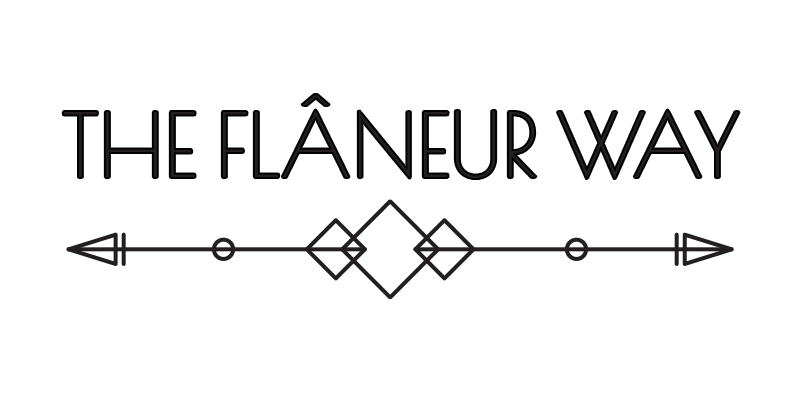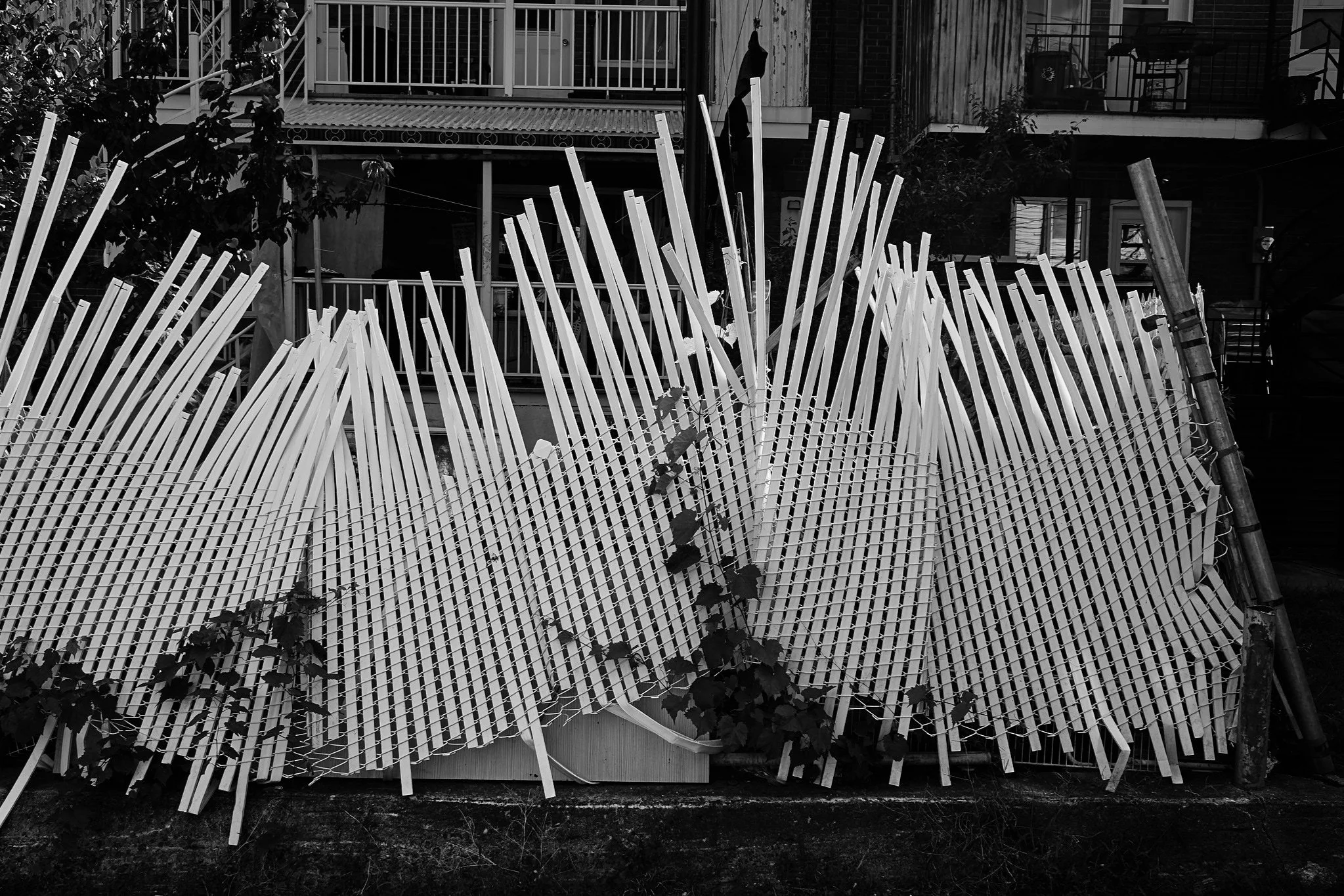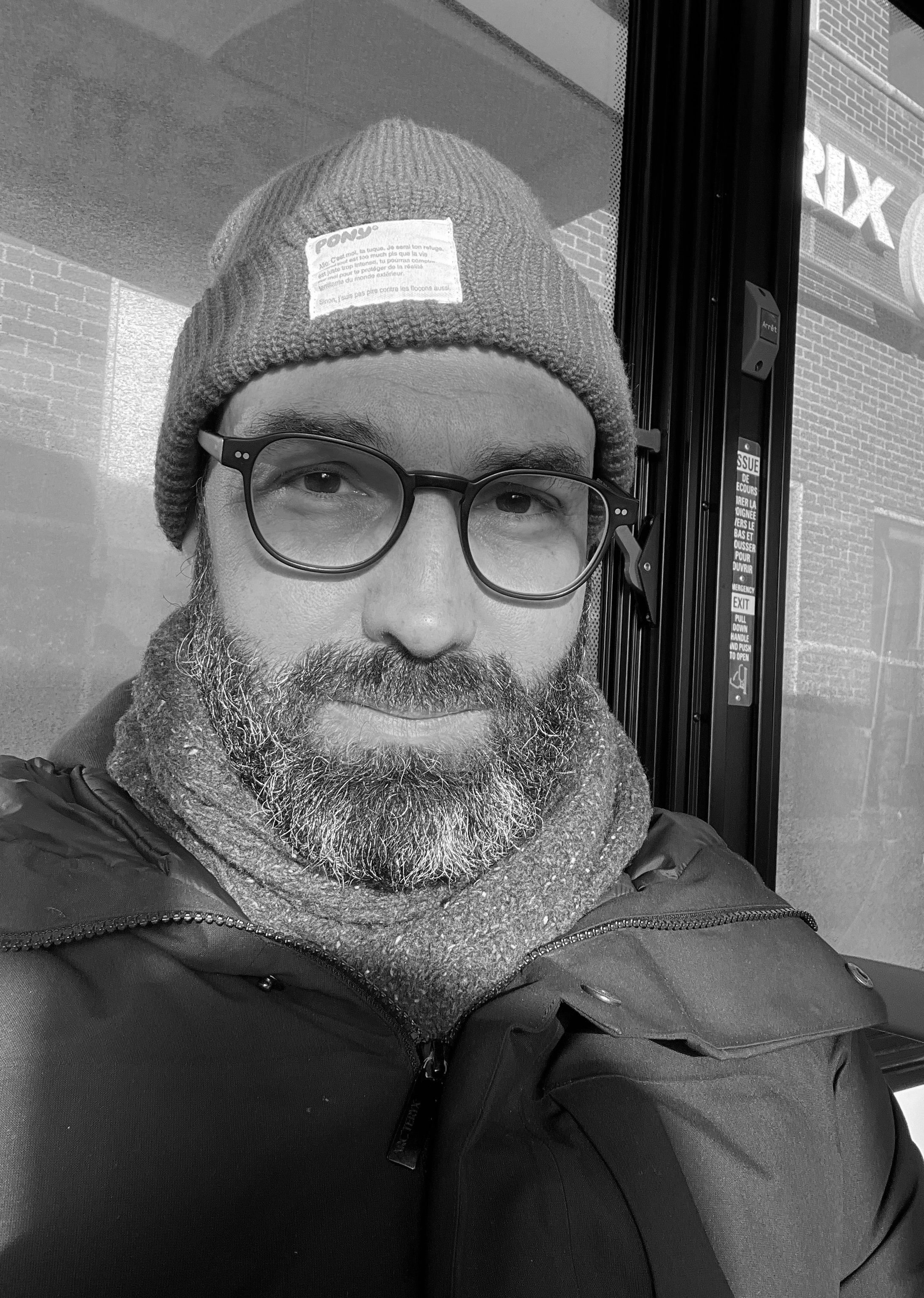
IN CONVERSATION
DEAN GARLICK : CREATIVE
Interview by Jennifer Cloutier
Jen : How did you get your start in Photography? What or who inspired it?
Dean: I started Photography as a serious art practice during the pandemic. I’d been writing a dystopian novel at the time and it was too much dystopia, both inside and outside of my head. So I started to take stress walks in the alleys of my neighbourhood to stay out of people’s faces. It was in the alleys that I began to notice the kinds of textures, colours and everyday scenes that would characterize my visual interest in the urban environment of Montreal. And it was Montreal as a city, and the ways that the seasons and light constantly change, that continued to inspire these walks, taking me further afield, into both residential and industrial areas of the city.
Jen: Was photography the first medium to express yourself, or were there others?
Dean: As a teen I used to draw a lot and write poetry, so there has always been an emphasis on the image in my creative output. My poetry practice transitioned into fiction writing in my twenties, and I wrote short stories and novels for many years. One novel, The Fish, was published on Anteism Press in 2009 with illustrations by Victoria artist, Eric Volet. René-Daniel Dubois translated it into French (Le Poisson) for Les Allusifs in 2014. I then put out a novella, Chloes, on my own imprint, ‘Lodge Press’, in 2015 with illustrations by local Montreal artist, Nicole Legault. As mentioned, I was well into my next novel when Covid hit, but long pandemic walks almost guaranteed my organic transition into photography. I still think about this book sometimes (the world I was creating) but all of my time and energy has shifted to the various aspects of my photography practice at this point. And that includes writing…about photography! :)
Jen: Can you tell us the initial moment you discovered photography as a tool to see and express yourself? ( the memory )
Dean: I can’t think of a particular moment when that happened. But at a certain point, I realized that photography was a way of curating reality within the frame. The frame is the ultimate constraint. This has made ‘filling the frame’ a continuous puzzle, or game that I play with the world around me when I’m out shooting. Light and shadow are endlessly compelling in the ways they can convey mood or tones of emotion, and capturing the aesthetic potential that is around us all the time is immensely satisfying. Even on the gloomiest, or coldest winter days, I come home with some images that surprise me. I sometimes see it as a kind of alchemy of the mundane.
Dean Garlick Photography
Jen: What are some of the themes that you are attracted to or engage with and why?
Dean: Generally speaking, I’m interested in capturing the city and its constant state of transformation. This includes evidence of urban decay and renewal, and especially the natural chemical and physical processes of weathering and deterioration that act on the material world. I’m also interested in the overflow of physical objects that occurs in cities, resulting in art-like installations of waste. I call these ‘sculptural circumstances’, and they are by far the biggest category of image in my archives.
Jen: Have you always lived in Montreal? Does Montreal have a unique urban landscape? Why or what makes it unique?
Dean: I am originally from Southern Ontario (born in Chatham and moved to the London area during high school). I spent a couple of years in Japan and Thailand after undergrad and then lived in Victoria, B.C. for seven years before moving to Montreal in 2009.
Montreal absolutely has a unique urban landscape. The high-density walk-ups and iron staircases that dominate the residential areas give the city a distinctive flavor, unlike any other city in North America. The alleys and small backyards that back onto them also give the people walking through them an intimate view of local lives (though privacy fences are quickly taking over in some neighbourhoods). As well, Montreal has an interesting mix of industrial and residential areas that are readily accessible, and there are vast swathes of ‘no man’s land’ on the east part of the island that offer reclaimed nature and artifacts of the city’s shipbuilding past.
Jen : What are some of your favorite places to wander in the city? Is there a favorite neighborhood you find yourself attracted to?
Dean : I live in Villeray, so I find myself wandering the alleys here quite a bit, but I go all over the city to take photos, including neighbourhoods like Parc-Extension, the Mile End, the Plateau, Hochelaga, Ville-Émard, Pointe-Saint-Charles, N.D.G, and several industrial areas of the city, such as around the Garment District, and along Boulevard Industriel. Each neighbourhood has its own flavour and mix of local residents that makes it unique, and I like to return in different seasons and conditions because the light is always hitting differently, and things continue to shift and change with time.
Jen : Is there a particular season you enjoy taking photos or is each season unique in its landscape? And why?
Dean: As I mentioned in the previous answer, the ever-shifting direction and quality of light in different seasons create completely different opportunities for image-making. For example, in winter, the light comes in at more of an angle, producing window reflections in the alleys that create ‘spotlights’ that can be utilized in creating compositions, or directly after summer rain, the wet surfaces reflect light differently than dry surfaces. For these reasons, I try to go out in all seasons and conditions, remaining open to the unique opportunities that are unique to each situation.
Jen: What kind of tools ( camera ) do you use these days to capture your visions?
Dean: I began with just my iphone, which is a great way to start. Everything you need as a photographer is in your pocket. (People have asked me if I feel the proliferation of cell phone cameras has somehow ‘ruined photography’, and to them I say that the proliferation of pens hasn’t made everyone writers, so we should calm the hysteria).
My first digital camera was a Fujifilm Xf10, which is a very compact APSC-sensor camera. It has a focal length equivalent to 28mm full frame, which basically makes it a phone camera with a larger sensor. I then bought myself a Fujifilm X100V, which has a 35mm equivalent lens, and this is now my ‘everyday carry’ camera (it’s always in my bag with me). I love its portability and onboard flash. And finally last year, I bought a Fujifilm GFX 50sii, which is a digital medium format camera. I like to pair it with vintage lenses to get a bit more of a filmic look to my images, and I thoroughly enjoy the feel and control of manually focussing. I’ve stayed within the Fujifilm ecosystem mostly out of convenience, but I do love the way their sensors and software resolve colour, and they are fun cameras to use for their physical manual dials.
Jen : What sorts of projects are you working on that you want to share with us?
Dean : I would say my approach to photography is ‘cumulative’. By that, I mean that I go out to shoot as an equal opportunist. I’m not looking for anything in particular, but for everything in particular. (It isn’t unusual for me to take over 100 images on a photo outing). This means that when I get home, I end up ordering and categorizing my images after-the-fact. This has resulted in a proliferation of nearly fifty different categories of subject matter in my archives, which now has nearly 25 000 photos in it. Through social media and a number of photo book projects, I’ve become more interested in the narrative potential of sequencing images, and this is where my archives (and individual projects) come in. I see the various categories of photo in my archive as a type of image lexicon. This means that for individual projects I can combine different types of images together to create a visual poetics distinct to that blend of photos. These can be sequenced in visual rhythms, with a nuanced emotional intensity that corresponds to the colour and brightness of individual photos. As a result, there are many potential projects at play in my photo archives depending on how I choose to combine and order different types of image. To give one example, I have a project that I call ‘mixed signals’ which combines high contrast monochrome images with close-up colour photos of urban telephone poles. The contrast in form and intensity between ‘quiet’ black-and-white images and ‘loud’ abstract splashes of texture and colour imparts a unique effect on the viewer that is fun to play with when sequencing images. (I’ve provided some examples of this project with our interview)
Jen : Who are some of your favorite artists, poets, photographers, and visionaries? ( dead or alive).
Dean : This is a big question, so I think I’ll focus on a few photographers who have made an impact on how I view photography. Firstly, I would say Daido Moriyama, because he showed me that anything can be a photo. Horizon lines don’t have to be straight, and a frame can be chaotic and still have its own internal logic, or a logic that speaks to and relates with another image in sequence. Secondly, Saul Leiter, who validated my predilection for the vertical frame, and whose eye for colour, form, and abstraction on the streets of New York helped me to see the potential for similar opportunities in the urban landscape of Montreal. Next, William Eggleston, and his ‘democratic forest’ project, which revealed that there are no unworthy subjects of a photograph. A well-lit garden hose can be just as noble as a mountain peak if framed under the appropriate conditions. Next, Lewis Baltz, another American photographer whose photos of industrial landscapes in the 70’s and 80’s speak directly to my own attraction to industrial minimalism today. Finally, Dimitra Dede, is a favourite contemporary photographer. Her work is suffused with texture and dark fabulist undertones that I connect with on a visceral level. I highly recommend her work.
Jen : Do you shoot analog or digital, and which do you prefer these days? Why?
Dean: I used to shoot film in my teens and twenties, especially during my travels in Asia and Mexico. But the volume of photos that I take these days makes shooting film impossible due to the cost of buying, developing, and scanning film. I do appreciate the unpredictability of film, the not-knowing how a set of images will turn out, and the random effects of light leaks, etc. For that reason, I like to shoot with vintage lenses (Helios 44-2/Jupiter 9) on digital cameras due to the analog feel and unpredictable optical effects these lenses can provide.
Jen : Can you tell me the importance of printing your work? Why do you choose to do so?
Dean: Printing photographs is a completely separate skill-set and process to learn, and an important component of photography for me. As a digital photographer, your photos live as files on your external hard drive, or they’re shared on a screen on your website or on social media, but in my opinion, nothing brings a photo into existence like printing it. There is a lot more I could say about this, such as the importance of the type of paper you choose, or how to properly prep a file for print, but this isn’t a printing tutorial, so I’ll just say that printing is an important consideration that I’d like to keep experimenting with and learning more about.
Printing is also a way to get your work out into the world, and hopefully, into people’s hands, or ideally, onto their walls. I’ve been lucky to find atelier Michel Seguin here in Montreal for my high quality, limited-edition prints. He has an impressive variety of paper, and he is happy to sit down and finesse the file with you on his next-level monitor, which can more-or-less show you exactly how the final product will look at scale. I also print postcards at Tsar Printers downtown. It takes a little more trial-and-error (for me) to get the files right in CMYK, but he is happy to work with you to adjust things, and his prices are very reasonable.
I’m also interested in making photo zines and photo books as printed art objects. The book format provides the opportunity to creatively sequence images, and sometimes work collaboratively. My last photo zine was a collaborative effort with Montreal photographer, Matthew Pobyryny, called, Call and Response (out on Urban Avalon Press). He sent me a number of photos and I responded with a series of pairings, which we co-edited into a limited edition zine. It was a fun project and a great way to engage with another photographer’s work.
Besides printing, I’ve recently also become interested in some of the other materiality possibilities of photography. This includes lightboxes, which project light from behind an image, and the use of multiple screens, which can dynamically display pairings of images in an ever-shifting sequence.
Jen : What are some of your accomplishments as a creative? Do you do it professionally or simply as a joyful creative act?
Dean: Photography is a therapeutic activity for me. It puts me out into the world and into the flow of the moment unlike any other creative practice I’ve pursued. It’s the opposite of writing in a number of ways. Writing, for me, is a way to represent the outside world through one’s interior, while photography is a way to represent one’s interior through the outside world. The fact that it is a physical activity (again, unlike writing) keeps me active and in a constant state of discovery. This is greatly beneficial to my sense of well-being. The fact that there is beauty in the most banal subject matter gives photography an air of magic that both feeds me creatively and reminds me of the generosity of existence. These are the things that keep me motivated to go out and make images as often as I do.
That being said, I have had a few accomplishments in the past year that I’m proud of. This fall I visited Portugal, where I had a photo in a show at m|i|mo (Museum of the Moving Image) in Leiria. For the past two years I have been a contributor to the Portuguese ‘fotografar palavras’ project (https://fotografarpalavras.blogspot.com/), which pairs poetry with photography. The curator of the project, Paulo Kellerman, periodically sends me a literary quote, and I pair it with an image. For the second year, one of my images has been in their year-end show at m|i|mo. It was very special for me to go there, meet Paulo, and see the work up on the wall at the museum. I’m also a monthly contributor to Sculpturaday (SAD), a project started ten years ago by Vancouver artist, Sara Graham. Sara posts daily ‘sculptural circumstances’ on both the project website (https://sculptureaday.ca/) and Instagram page (https://www.instagram.com/sculptureaday/). This past year, Lorenzo Servi, a Finnish art-book publisher included four of my SAD photos in his book, Involuntary Sculptures. This is the sixth book in his The City is Ours series (.https://shop.serraglia.com/). Finally, my 2023 Knife Fork Book photo zine, Domestic Sublime, won ‘Best English Zine’ at this year’s Expozine awards. This was a pretty great surprise, as it was my third time to be nominated for the award. (The first two times were for fiction writing).












